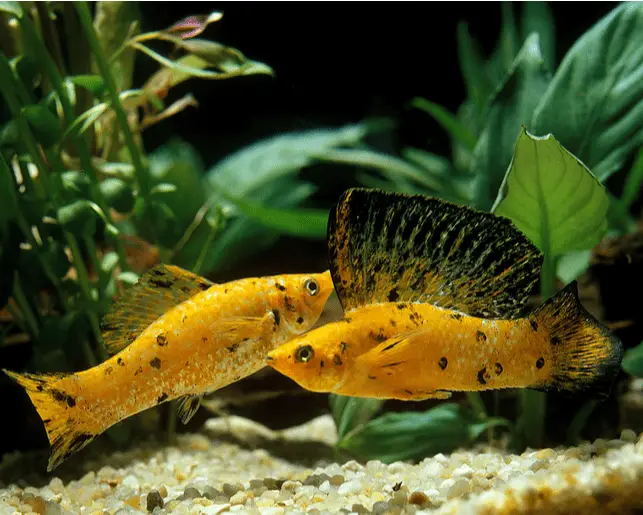Mollies are a very popular fish for beginners to fishkeeping. They are incredibly hardy, very peaceful (although they can be a little bit feistier than guppies or platys), and come in some lovely colours and patterns.
As with all breeds of fish, keeping them stress free is an important part in your role as a fish parent. One of the main ways to keep your fish happy is to try and replicate their natural environment.
Water movement, or current, is something that needs to be considered.
Mollies do not generally like current in their aquarium environment because they are used to rivers and bodies of water that move very slowly and are shallow. They are a hardy species though, so would have no problem adapting to a gentle current.

Do Mollies Like Current?
Mollies can live in a gentle current but thrive better with no current. They originally come from small streams and ponds in and around Central America and southern North America, which are relatively calm. Over the years, pet mollies have been bred in captivity in very slow moving (if at all) environments.
Natural Habitat for Mollies.
In the wild, mollies are found in places like small streams, wetlands, rivers, coastlines, and pools that are attached to larger bodies of water. They prefer the shallower water, mainly due to their small size. The deeper the water, the more chance of bigger fish, many of whom are predators, will eat them. Mollies have been known to venture in and out of brackish water, and sometimes even saltwater, which is why they are such a hardy breed.
Ideal temperature ranges for mollies are between 23°C and 28°C (75°F and 82°F). While mollies are very hardy creatures, try to avoid temperature fluctuations as that will unsettle them. They need to be in a steady environment.
The ideal pH for mollies is around 7.5
How to Recreate a Natural Habitat for Mollies.
Firstly, you need to make sure your tank is big enough for your mollies to be happy in. They need lots of space to swim around. My mollies use every part of the tank, but they seem to favour the middle and top, so make sure it is nice and tall as well as big.
Mollies spend a lot of time at the surface and the middle of the tank, so tall plants are an excellent way to encourage them to swim up. Free-floating aquarium plants also add to the authenticity of the aquarium.
Add rocks, driftwood and a few ornaments to provide enough hiding places and break up any strong water currents.

What Can Cause Current in a Fish Tank?
Mollies will get exhausted very easily in water that has a strong current due to their small size. What are the possible causes of too much current in a fish tank?
The Filter.
The filter can cause a current in a fish tank when it is too powerful or too large for the tank it’s placed in. It is recommended to choose smaller tanks for keeping your molly healthy and happy.
If your aquarium’s filter current is too strong, your molly may struggle to swim and forage for food. It might become anxious and exhibit signs of stress.
Loss of Water.
You will notice more movement in the water as your water tank level goes down naturally. Make sure your tank is always topped up to stop this from happening.
This article might help – Why does the water level in my fish tank go down?
Air Pump.
If you have an air pump in your tank, this is obviously going to cause a lot more movement in the water. Now, whilst this might be good news for some fish, it isn’t great for your mollies. It is always a good idea to check if any potential new fish you want to add are ok with current before buying them.
Bigger Fish.
If you put your mollies into a tank that has a lot of bigger, active fish in, their natural movement around the tank can cause significant movement in the water, especially if they are schooling fish so you have a group of them!
How To Tell if a Molly Is Stressed.
One of the first signs that your molly is stressed is a change in its normal playful behaviour. Stressed fish tend to hide themselves away and not be a part of their group.
In a stressed state, your molly may hide for long periods. When you do catch a glimpse of him, he may be swimming in unusual patterns.
The company your molly keeps may also cause him stress. Mollies thrive best when kept in a peaceful community tank, ideally with some more mollies.
Always make sure you have your male to female ratio correct. Mollies should be kept as one male for every three females. If there are too many males and not enough females, the males will constantly chase and harass them.
Look out for any signs of stress from your mollies if you introduce any new tank mates. The males could get a bit tetchy at first with any new additions, especially if they like the same parts of the tank that they do.
Cory Catfish (Corydoras) make ideal tank mates because they enjoy similar aquatic environments and are bottom-dwellers, so will be mostly out of their way.
How To Reduce a Strong Current in a Fish Tank.
The first thing you can do to reduce the strong current in your fish tank is to locate the flow adjustor of the aquarium filter.
The filter may be too powerful for your tank. A power filter is not appropriate for a 10- to 30-gallon (37.85 to 113.5-liter) aquarium. Try installing a simpler sponge filter with an air pump that can be adjusted for a gentler flow.
You can block the input with a sponge light enough that it doesn’t restrict the pump or prevents it from working correctly.
You can also block the output with a filter baffle to slow the current. Here is a video showing you how to make a baffle using simple materials:
Another simple trick to reduce the water flow is to disperse the outflow toward the back wall of the fish tank or toward the surface of the water.
Finally, place some live plants underneath the outflow pipe to break up the water current as it enters the fish tank.
Conclusion.

Mollies are very popular with many first-time aquarium hobbyists. Setting up a basic tank that meets your molly’s needs is simple and does not require much maintenance as they are a hardy breed.
It’s essential that you maintain a gentle current to avoid stressing your fish. Happy mollies can live anywhere between one and three years if they are happy in their tank.

